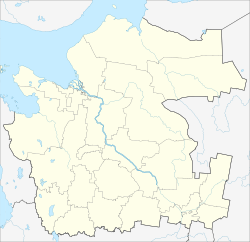Top Qs
Timeline
Chat
Perspective
Nyonoksa
Selo in Arkhangelsk Oblast, Russia From Wikipedia, the free encyclopedia
Remove ads
Nyonoksa, also Nenoksa,[4] (Russian: Нёнокса pronounced [ˈnʲɵnəksə]) is a rural locality (a selo) under the administrative jurisdiction of Severodvinsk Town of Oblast Significance, Arkhangelsk Oblast, Russia. It is located at the coast of the Dvina Bay of the White Sea (the Summer Coast) 19 miles (31 km) northwest of the city of Severodvinsk. The Nyonoksa railway station is 1.2 miles (1.9 km) from Nyonoksa at the mostly military village of Sopka along the Northern Railway line from Severodvinsk. Nyonoksa is accessible by land vehicles only during the winter months when the nearby swampland freezes.
You can help expand this article with text translated from the corresponding article in Russian. (August 2019) Click [show] for important translation instructions.
|
Remove ads
Missile testing site
Summarize
Perspective
Established in 1954 near Nyonoksa is "The State Central Navy Testing Range" (Russian: «Государственный центральный морской полигон») which is the main rocket launching site of the Soviet Navy and later the Russian Navy and is also called Nyonoksa.[5] The naval missile range is also known as military unit 09703.[6][a] Since 1965 numerous rockets of the types R-27, R-29, R-39 Rif and R-39M were launched from Nyonoksa. These rockets were prototypes for the employment on missile submarines. The launching site is located in the mostly military settlement of Sopka (Russian: Сопка), which has a railroad station, hosts the military unit 09703, has a population similar to Nyonoksa of about 500, and is 2 kilometres (1.2 mi) north of the selo of Nyonoksa.[9][10][11][12]
On 15 December 2015 at 11am, an accident during a missile launch test resulted in a block of flats in the mostly military village of Sopka, which is part of Nyonoksa, being hit by part of a rocket. A fire broke out, but all residents were evacuated in time.[13][14]
2019 explosion
On 8 August 2019 an explosion occurred at or near the test site killing five and injuring six (or three) people.[15][16] The explosion was followed by a brief spike in radiation levels.[16] According to Rosatom the explosion happened on a sea platform when a "liquid-propellant engine" was tested.[citation needed] While Russian authorities did not disclose what the power source was intended for, some Russian media as well as U.S. President Donald Trump have linked the event to the development of the nuclear-powered cruise missile 9M730 Burevestnik, also known by its NATO reporting name as the SSC-X-9 Skyfall.[17][18]
Remove ads
Culture and recreation
Nyonoksa hosts 7 objects which are protected as cultural heritage monuments at the federal level.[19][20] They are grouped in two ensembles. The Nyonokotsky Pogost is one of the few surviving triple wooden church ensembles, consisting of two churches (a bigger, unheated, church used in the summer, a smaller, heated church used in the winter) and a bell-tower.[21] The Nyonoksa churches are the St. Nicholas Church (1763) and the Trinity Church (1727).[21] Nyonoksa was also notable for salt production.[10][21] Another ensemble, the salt production complex, is neglected since the Great Patriotic War (WWII).[10][21]
Remove ads
History
Summarize
Perspective
Neolithic settlements from 2000 to 1000 BC at Nyonoksa - Sopka (Russian: «Нёнокса — Сопка») located 4 kilometres (2.5 mi) from Nyonoksa were excavated in 1893.[10][21]
The city charter dates from 1397 under Novgorod and later Muscovy rule.[10] The city was named Nyo from Old Scythian meaning "fast flowing river" and Oxa from Finno-Ugric tribes meaning "river" or "small stream". Another version claims that the settlement is named after a Finno-Ugric leader named Niyuksa Soake (Russian: Ниюкса Соаке).[10][21]
Salt production began during the 1000s and lasted until rich sources were discovered in the Urals during the 1800s which led to Nyonoksa's salt trade ending the early 1900s.[10][21]
In 1419 and 1445, Norwegian Vikings or Northmen sacked wealthy Nyonoksa.[22]
In 1553, an English ship the Edward Bonaventure in the Hugh Willoughby expedition and captained by Richard Chancellor and Clement Adams arrived during England's search for the Northern Sea Route to China and India and thus opened Russia under Czar Ivan IV to English merchants.[10][23][24][b] The ship's captain and crew were taken to Czar Ivan IV[c] while the ship was repaired.[10] Following repairs Edward Bonaventure sailed for London in 1556 with the first Russian ambassador to England aboard, Osep Gregorovitch Napea, arriving in London in 1557.[23][24][26] This began the formal diplomatic relations between England and Russia.[10] Nyonoksa was Russia's original "window to England" (Russian: «окном в Англию»).[10]
Notes
- According to a 25 February 2008 Kommersant article, the 45th State Central Testing Range at Nyonoksa is part of the 20 August 1940 established White Sea Naval Base with Commander Rear Admiral Vitaly Fedorin (Russian: контр-адмирал Виталий Федорин) the commanding officer as of February 2008 and, as of December 2012, Captain I Rank Viktor Liina (Russian: капитан I ранг Виктор Лиина; born 1968), who previously was the Deputy Commander of the Northern Fleet's submarine forces, was the commanding officer.[7][8]
- During the winter of 1553-4, two other ships in the expedition, the Bona Esperanza and the Bona Confidentia, were left frozen fast in the Arctic ice pack in the mouth of the Arzina River (Russian: Арзина река) east of the Pechenga Monastery and later were found with their crews frozen.[24][25]
- Ivan IV also known as Ivan the Terrible, the first Czar of all Russia, was reigning during the ship's visit.
Remove ads
References
Wikiwand - on
Seamless Wikipedia browsing. On steroids.
Remove ads




